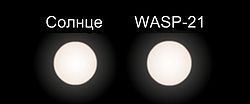WASP-21
WASP-21 is a G-type star (spectral type G3V) that is reaching the end of its main sequence lifetime[4][5] approximately 850 light years from Earth in the constellation of Pegasus that is relatively metal-poor, having 40% of heavy elements compared to the Sun.[5] Kinematically, WASP-21 belongs to the thick disk of the Milky Way.[1]
 Size comparison between Sun and WASP-21 | |
| Observation data Epoch J2000 Equinox J2000 | |
|---|---|
| Constellation | Pegasus |
| Right ascension | 23h 09m 58.25s[1] |
| Declination | +18° 23′ 45.9″[1] |
| Apparent magnitude (V) | 11.58 ± 0.08[1] |
| Characteristics | |
| Spectral type | G3V |
| Astrometry | |
| Radial velocity (Rv) | -89.45 [1] km/s |
| Proper motion (μ) | RA: 17.597 ± 0.074 [2] mas/yr Dec.: 18.867 ± 0.05 [2] mas/yr |
| Parallax (π) | 3.8412 ± 0.0427[2] mas |
| Distance | 849 ± 9 ly (260 ± 3 pc) |
| Absolute magnitude (MV) | 4.97 |
| Details | |
| Mass | 0.89 ± 0.071[3] M☉ |
| Radius | 1.136 ± 0.049[3] R☉ |
| Surface gravity (log g) | 4.277 ± 0.025[3] cgs |
| Temperature | 5800 ± 100[1] K |
| Metallicity | -0.4 ± 0.1 [1] |
| Metallicity [Fe/H] | -0.46 ± 0.11 [1] dex |
| Rotational velocity (v sin i) | 1.5 ± 0.6 [1] km/s |
| Age | 12 ± 5[1] Gyr |
| Other designations | |
| Database references | |
| SIMBAD | data |
The survey in 2012 have failed to find any stellar companions to WASP-21.[6]
Naming
In 2019 the WASP-21 system was chosen as part of the NameExoWorlds campaign organised by the International Astronomical Union, which assigned each country a star and planet to be named. WASP-21 was assigned to Bulgaria. The winning proposal named the star Tangra after a deity worshipped by the early Bulgars, and the planet Bendida after a deity worshipped by the Thracians.[7]
Planetary System
In 2010 WASP-21 was discovered to host a hot Jupiter type planet by the Wide Angle Search for Planets (WASP).[1] and confirmed by radial velocity by the WASP team in 2010.
Transit-timing variation analysis in 2015 did not find an additional planets in the system.[5]
In 2020, spectroscopic analysis has found the WASP-21 b atmosphere is mostly cloudless and contains sodium.[8]
| Companion (in order from star) |
Mass | Semimajor axis (AU) |
Orbital period (days) |
Eccentricity | Inclination | Radius |
|---|---|---|---|---|---|---|
| b | 0.276 ± 0.018 MJ | 0.0499 ± 0.0013 | 4.322482 | 0.0 [1] | 86.97 ± 0.33° | 1.162 RJ |
References
- Bouchy, F.; Hebb, L.; Skillen, I.; Collier Cameron, A.; Smalley, B.; Udry, S.; Anderson, D. R.; Boisse, I.; Enoch, B.; Haswell, C. A.; Hébrard, G.; Hellier, C.; Joshi, Y.; Kane, S. R.; Maxted, P. F. L.; Mayor, M.; Moutou, C.; Pepe, F.; Pollacco, D.; Queloz, D.; Ségransan, D.; Simpson, E. K.; Smith, A. M. S.; Stempels, H. C.; Street, R.; Triaud, A. H. M. J.; West, R. G.; Wheatley, P. J. (2010). "WASP-21b: A hot-Saturn exoplanet transiting a thick disc star". Astronomy and Astrophysics. 519: A98. arXiv:1006.2605. Bibcode:2010A&A...519A..98B. doi:10.1051/0004-6361/201014817.
- Brown, A. G. A.; et al. (Gaia collaboration) (August 2018). "Gaia Data Release 2: Summary of the contents and survey properties". Astronomy & Astrophysics. 616. A1. arXiv:1804.09365. Bibcode:2018A&A...616A...1G. doi:10.1051/0004-6361/201833051. Gaia DR2 record for this source at VizieR.
- Ciceri, S.; Mancini, L.; Southworth, J.; Nikolov, N.; Bozza, V.; Bruni, I.; Calchi Novati, S.; d'Ago, G.; Henning, Th. (2013). "Simultaneous follow-up of planetary transits: Revised physical properties for the planetary systems HAT-P-16 and WASP-21". Astronomy & Astrophysics. 557: A30. arXiv:1307.5874. Bibcode:2013A&A...557A..30C. doi:10.1051/0004-6361/201321669.
- Barros, S. C. C.; Pollacco, D. L.; Gibson, N. P.; Howarth, I. D.; Keenan, F. P.; Simpson, E. K.; Skillen, I.; Steele, I. A. (2011). "A lower mass for the exoplanet WASP-21b". Monthly Notices of the Royal Astronomical Society. 416 (4): 2593–2599. arXiv:1106.2118. Bibcode:2011MNRAS.416.2593B. doi:10.1111/j.1365-2966.2011.19210.x.
- Ground-based transit observations of the HAT-P-18, HAT-P-19, HAT-P-27/WASP40 and WASP-21 systems, 2015, arXiv:1508.06215
- A lucky imaging multiplicity study of exoplanet host stars, 2012, arXiv:1202.4586
- "Bulgaria | NameExoworlds". Name Exoworlds. 2019-12-17. Retrieved 2019-12-30.
- Detection of Na in WASP-21b’s lower and upper atmosphere, 2020, arXiv:2007.13429